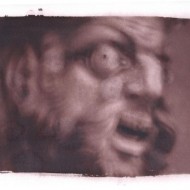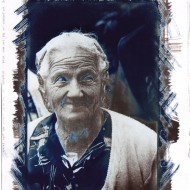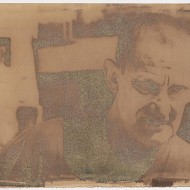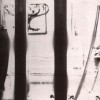
The majority of cyanotype tonings use two baths: a tanning agent as tea, coffee or, obviously, the tannic acid itself and an alkali, usually sodium carbonate. Their order can be inverted, with or without washing before and between the two baths, in different concentrations… all of the combinations give give quite different effects. It is also possible to repeat toning, for example tanning-alkali-tanning.
Possibilities are never-ending.
Ammonia as basic bath is an alternative to calcium carbonate that is often cited in literature. Yesterday night I made some preliminary tests using a 13% ammonia solution bought from the grocer store and the discount soluble coffee. All of the prints were discards on which make tests, too contrasted pictures, overexposed, with stains or too much pixelated. I used them just to familiarize with the procedure.
I tried some baths using 40ml, 20ml and 10ml of 13% diluted ammonia in a liter of water. As the color changed rapidly, I choose the 10ml per liter solution and it is probably possible to use a smaller concentration. Besides, if you want to completely bleach the image, it is better to use 40ml.
Lonesome ammonia in cyanotype tonings
The two-second diluted ammonia bath gives a beautiful purplish color, which loses significantly density during the water washing. If the print is dried without washing, the hue gets lost during the drying. It only remains a slight purple and cold tonality that is more pleasurable than the brilliant not toned blue cyanotype, but the bath reduces the dmax and flattens the tones at the same time. I don’t like this result at all! And don’t forget the preservation and stability problems described in the following paragraphs.
When used to bleach a cyanotype, ammonia behaves as a linear reducer, which means that it turns down the density of the entire print, both of shadows and lights. Its final hue is dark blue, more pleasurable than the one obtained bleaching into peroxide, which produces a greenish unpleasant dominant.
In any case, bleaching without redeveloping in a tanning agent is something to be avoided, because this procedure transforms the prussian blue in ferric hydroxide, which is unstable. Only tanning can guarantee a correct preservation of the images. In fact, as already said in basicity and color of blue prints, cyanotype tonings are stable even when time goes by because tanning agents transform again ferric hydroxide in ferrotannic (or ferrogallic) compounds. They are extremely stable compounds, used for ink of hand-copied books that past through centuries without paling.
Tea or coffee in cyanotype tonings
After bleaching a print, I put it in a bath with 50g of soluble coffee and 500ml of water, but unfortunately this last didn’t put on density. Notwithstanding the image is delicate and pleasurable, almost transparent, neutral grey with a slightly blue dominant in deepest shadows.

I only hope coffee would have been enough to convert the biggest part of the ferric hydroxide, in a way that the image doesn’t significantly change in time.
The coffee bath didn’t work for any image, even in short ammonia bath or long coffee bath (I left one image the entire night inside the bath and it only turned a little brown hue, moreover maculated. Advantage: it now has a wonderful coffee scent!).
Maybe the bath concentration must be augmented, even if coffee was completely black. I though, after buying the package, noticed that it only have 40% coffee and the rest additives, so maybe it is necessary a real coffee.
I then worked with the tea bath: 4 tea bags in boiling water.
The best result of the entire session came with a 3-minutes tea bath followed by 2/3-seconds quick immersion inside the ammonia bath. The print gets a pleasing split-tone effect, dark blue shadows and warm grey vaguely pink lights.
Na2CO3 comparison and gelatine tanning in cyanotype toning
Using tea and sodium carbonate instead of ammonia turns hue into more brown and yellow color. Pure tannic acid and sodium carbonate have high pink lights, almost unpleasant, but some wonderful black shadows. Tea and ammonia instead are between the two, lights of a neutral grey, pink and brown that I found genuinely nice and dark blue shadows.

A collateral effect of the experiments is the toning effect on gelatine-sized paper. In fact, one of the prints was only-shadows cyanotype base on Rives BFK. I wanted to put on it bichromed gums that but I never did it, so the paper was sized after the cyanotype print with a 5% hardened in formaldehyde gelatine solution. The gelatine is strongly tanned by tea, turning in a browned-pink pronounced color. If you want to tone a cyanotype print as a bichromed gum base and if you want to obtain some pure whites, toning must be done before sizing. On the contrary, you can size a print before toning if you want to amplify the tea color on paper.
Tanning acidification in cyanotype toning
Some forum recommend to slightly acidify tannates bath, some other suggest an acid bath to rapidly stop the toning effect. Those advices are contradictory, so I tried to add a drop of acetic acid to tea, to verify how a cyanotype behaves in an acid-tanning bath. Tea suddenly got clear, passing from dark brown to light brown, but stopped functioning. Prints inside acid cyanotype simply didn’t tone.
I therefore think that an acid bath is more useful as tanning arrest than as tanning additive.


































complimenti! interessante articolo.
Very interesting! I have been developing my B&W negatives with “Caffenol” a solution that uses instant coffee, sodium carbonate (washing soda) and acorbic acid (crushed vitamin C tablets). I think I’m going to make a film developing recipe and try it to develop some cyanotype prints on paper. You don’t mention the ratios in your article. For my Caffenol, I use 5 teaspoons of instant coffee, 2 teaspoons of sodium bicarbonate, and 1 teaspoon of crushed vitamin c tablets per 500 ml water. I wonder if the ratio of coffee to sodium carbonate is similar to my recipe?
Hi Juliet,
thank you very much for your comment.
My English is far to be perfect, so maybe the article was not that clear. I did not mention the ratio because it’s not a single bath. I have 2 trays one with an ammonia solution, one with coffee. Concentrations for each bath are in the article.
Do you have a website where I can have a look to your cyanotype prints?
You can also subscribe to this post comments RSS feed.